On the Spectral Efficiency for Distributed Massive MIMO Systems
Abstract
:1. Introduction
- A field study on the spectral efficiency of distributed MIMO systems for the sub–6 GHz band that quantifies the losses of spectral efficiency due to power unbalance in several distributed MIMO systems working together. In this paper, channel propagation measurements are acquired in reverberation chambers to emulate different environments;
- A theoretical study is carried out in order to simulate a distributed massive MIMO system in the mmWave band. A deep analysis on the spectral efficiency is presented using the NYUSIM simulator;
- A field study is performed to emulate a distributed MIMO system in the mmWave band. A measurement campaign is performed to emulate several distributed MIMO scenarios above 30 GHz. A comparison with the power unbalance in the sub–6 GHz band is made in order to see the implementation viability of distributed MIMO scenarios for future mobile generations.
2. Distributed MIMO Model
3. Power Unbalance on Sub–6 Ghz D-MIMO Systems
3.1. Measurement Scenario
3.2. Power Balance Analysis
4. Correlation and Los on Emulated D-MIMO Systems above 6 Ghz
4.1. Emulation Scenario
4.2. Correlation and LoS Analysis
5. D-MIMO System on a Semi-Anechoic and Semi-Reverberation Chamber in the mmWave Band
5.1. Measurement Scenario
5.2. Anechoic and Reverberation Channel Analysis
6. Conclusions
Author Contributions
Funding
Data Availability Statement
Acknowledgments
Conflicts of Interest
References
- Ericsson. Ericsson Mobility Report June 2021. 2021. Available online: https://www.ericsson.com/4a03c2/assets/local/mobility-report/documents/2021/june-2021-ericsson-mobility-report.pdf (accessed on 29 September 2021).
- Cisco. Cisco Annual Internet Report (2018–2023). 2020. Available online: https://www.cisco.com/c/en/us/solutions/collateral/executiveperspectives/annual-internet-report/white-paper-c11-741490.html (accessed on 29 September 2021).
- Han, B.; Liu, Y.; Qian, F. ViVo: Visibility-aware mobile volumetric video streaming. In Proceedings of the 26th Annual International Conference on Mobile Computing and Networking, London, UK, 21–25 September 2020; Association for Computing Machinery: New York, NY, USA, 2020; pp. 1–13. [Google Scholar]
- Ramirez-Arroyo, A.; Zapata-Cano, P.H.; Palomares-Caballero, A.; Carmona-Murillo, J.; Luna-Valero, F.; Valenzuela-Valdes, J.F. Multilayer Network Optimization for 5G & 6G. IEEE Access 2020, 8, 204295–204308. [Google Scholar]
- Albreem, M.A.; Juntti, M.; Shahabuddin, S. Massive MIMO Detection Techniques: A Survey. IEEE Commun. Surv. Tutor. 2019, 21, 3109–3132. [Google Scholar] [CrossRef] [Green Version]
- MacCartney, G.R.; Rappaport, T.S. Millimeter-Wave Base Station Diversity for 5G Coordinated Multipoint (CoMP) Applications. IEEE Trans. Wirel. Commun. 2019, 18, 3395–3410. [Google Scholar] [CrossRef]
- Jungnickel, V.; Manolakis, K.; Zirwas, W.; Panzner, B.; Braun, V.; Lossow, M.; Sternad, M.; Apelfröjd, R.; Svensson, T. The role of small cells, coordinated multipoint, and massive MIMO in 5G. IEEE Commun. Mag. 2014, 52, 44–51. [Google Scholar] [CrossRef]
- Zhang, J.; Ji, Y.; Jia, S.; Li, H.; Yu, X.; Wang, X. Reconfigurable Optical Mobile Fronthaul Networks for Coordinated Multipoint Transmission and Reception in 5G. J. Opt. Commun. Netw. 2017, 9, 489–497. [Google Scholar] [CrossRef]
- Yu, Y.-J.; Hsieh, T.-Y.; Pang, A.-C. Millimeter-Wave Backhaul Traffic Minimization for CoMP Over 5G Cellular Networks. IEEE Trans. Veh. Technol. 2019, 68, 4003–4015. [Google Scholar] [CrossRef]
- Bassoy, S.; Farooq, H.; Imran, M.A.; Imran, A. Coordinated Multi-Point Clustering Schemes: A Survey. IEEE Commun. Surv. Tutor. 2017, 19, 743–764. [Google Scholar] [CrossRef]
- Bassoy, S.; Imran, M.A.; Yang, S.; Tafazolli, R. A Load-Aware Clustering Model for Coordinated Transmission in Future Wireless Networks. IEEE Access 2019, 7, 92693–92708. [Google Scholar] [CrossRef]
- Chen, S.; Zhao, T.; Chen, H.-H.; Lu, Z.; Meng, W. Performance Analysis of Downlink Coordinated Multipoint Joint Transmission in Ultra-Dense Networks. IEEE Netw. 2017, 31, 106–114. [Google Scholar] [CrossRef]
- Schwarz, S.; Rupp, M. Exploring Coordinated Multipoint Beamforming Strategies for 5G Cellular. IEEE Access 2014, 2, 930–946. [Google Scholar] [CrossRef]
- Marotta, A.; Cassioli, D.; Antonelli, C.; Kondepu, K.; Valcarenghi, L. Network Solutions for CoMP Coordinated Scheduling. IEEE Access 2019, 7, 176624–176633. [Google Scholar] [CrossRef]
- Li, L.; Yang, C.; Mkiramweni, M.E.; Pang, L. Intelligent Scheduling and Power Control for Multimedia Transmission in 5G CoMP Systems: A Dynamic Bargaining Game. IEEE J. Sel. Areas Commun. 2019, 37, 1622–1631. [Google Scholar] [CrossRef]
- Georgakopoulos, P.; Akhtar, T.; Politis, I.; Tselios, C.; Markakis, E.; Kotsopoulos, S. Coordination Multipoint Enabled Small Cells for Coalition-Game-Based Radio Resource Management. IEEE Netw. 2019, 33, 63–69. [Google Scholar] [CrossRef]
- Mismar, F.B.; Evans, B.L. Deep Learning in Downlink Coordinated Multipoint in New Radio Heterogeneous Networks. IEEE Wirel. Commun. Lett. 2019, 8, 1040–1043. [Google Scholar] [CrossRef] [Green Version]
- Song, G.; Wang, W.; Chen, D.; Jiang, T. KPI/KQI-Driven Coordinated Multipoint in 5G: Measurements, Field Trials, and Technical Solutions. IEEE Wirel. Commun. 2018, 25, 23–29. [Google Scholar] [CrossRef]
- Park, S.; Alkhateeb, A.; Heath, W.R., Jr. Dynamic Subarrays for Hybrid Precoding in Wideband mmWave MIMO Systems. IEEE Trans. Wirel. Commun. 2017, 16, 2907–2920. [Google Scholar] [CrossRef]
- Li, J.; Wang, D.; Zhu, P.; Wang, J.; You, X. Downlink Spectral Efficiency of Distributed Massive MIMO Systems with Linear Beamforming Under Pilot Contamination. IEEE Trans. Veh. Technol. 2018, 67, 1130–1145. [Google Scholar] [CrossRef] [Green Version]
- Lv, Q.; Li, J.; Zhu, P.; You, X. Spectral Efficiency Analysis for Bidirectional Dynamic Network with Massive MIMO Under Imperfect CSI. IEEE Access 2018, 6, 43660–43671. [Google Scholar] [CrossRef]
- Marzetta, T.L.; Larsson, E.G.; Yang, H.; Ngo, H.Q. Fundamentals of Massive MIMO; Cambridge University Press: Cambridge, UK, 2018. [Google Scholar]
- Loyka, S.; Levin, G. On physically-based normalization of MIMO channel matrices. IEEE Trans. Wirel. Commun. 2009, 8, 1107–1112. [Google Scholar] [CrossRef]
- Valenzuela-Valdes, J.; Martinez-Gonzalez, A.; Sanchez-Hernandez, D. Emulation of MIMO Nonisotropic Fading Environments with Reverberation Chambers. IEEE Antennas Wirel. Propag. Lett. 2008, 7, 325–328. [Google Scholar] [CrossRef] [Green Version]
- Valenzuela-Valdes, J.; Martinez-Gonzalez, A.; Sanchez-Hernandez, D. Diversity Gain and MIMO Capacity for Nonisotropic Environments Using a Reverberation Chamber. IEEE Antennas Wirel. Propag. Lett. 2009, 8, 112–115. [Google Scholar] [CrossRef] [Green Version]
- Ju, S.; Kanhere, O.; Xing, Y.; Rappaport, T.S. A Millimeter-Wave Channel Simulator NYUSIM with Spatial Consistency and Human Blockage. In Proceedings of the 2019 IEEE Global Communications Conference (GLOBECOM), Waikoloa, HI, USA, 9–13 December 2019; pp. 1–6. [Google Scholar]
- Ramírez-Arroyo, A.; Alex-Amor, A.; García-García, C.; Palomares-Caballero, Á.; Padilla, P.; Valenzuela-Valdés, J.F. Time-Gating Technique for Recreating Complex Scenarios in 5G Systems. IEEE Access 2020, 8, 183583–183595. [Google Scholar] [CrossRef]
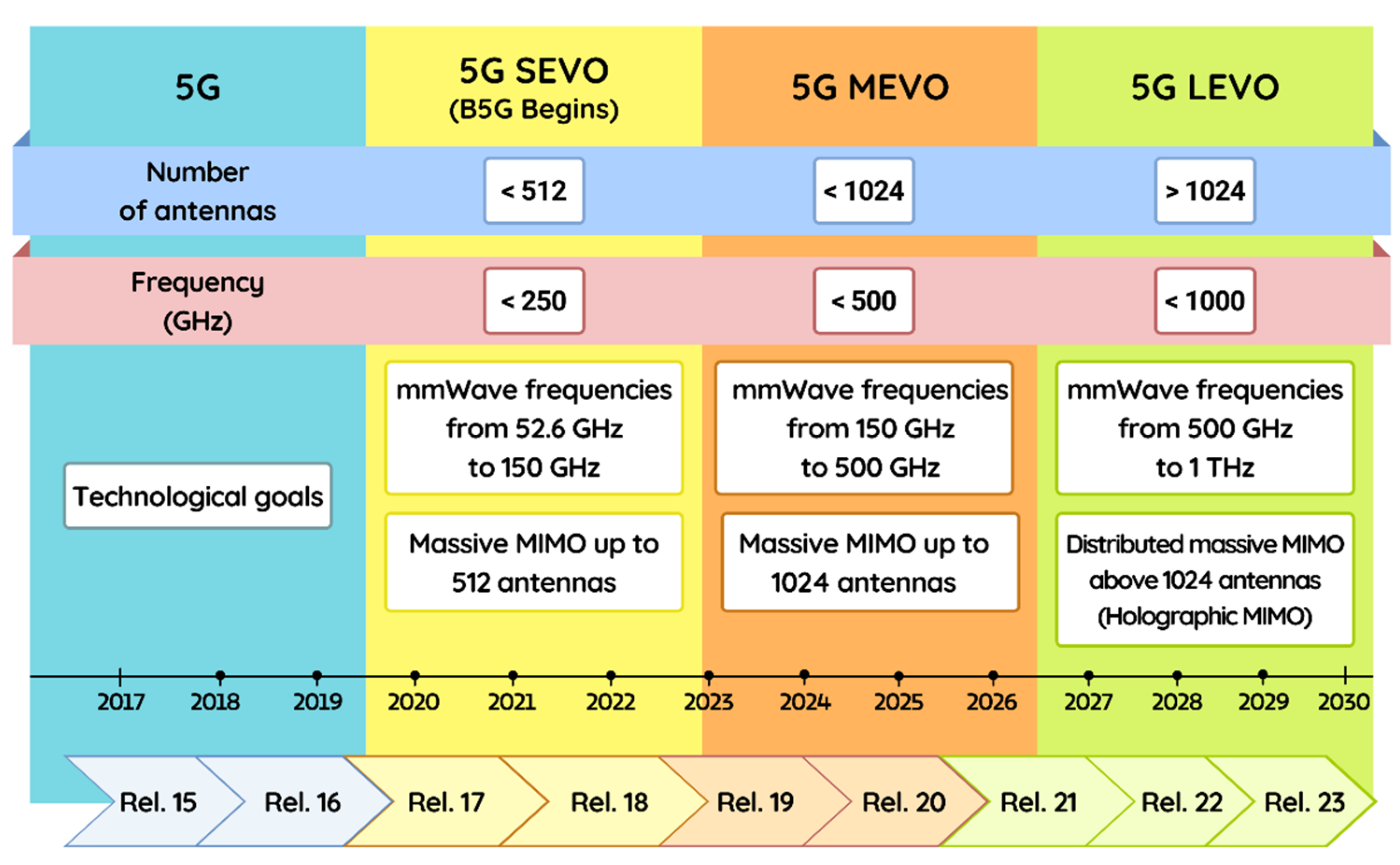
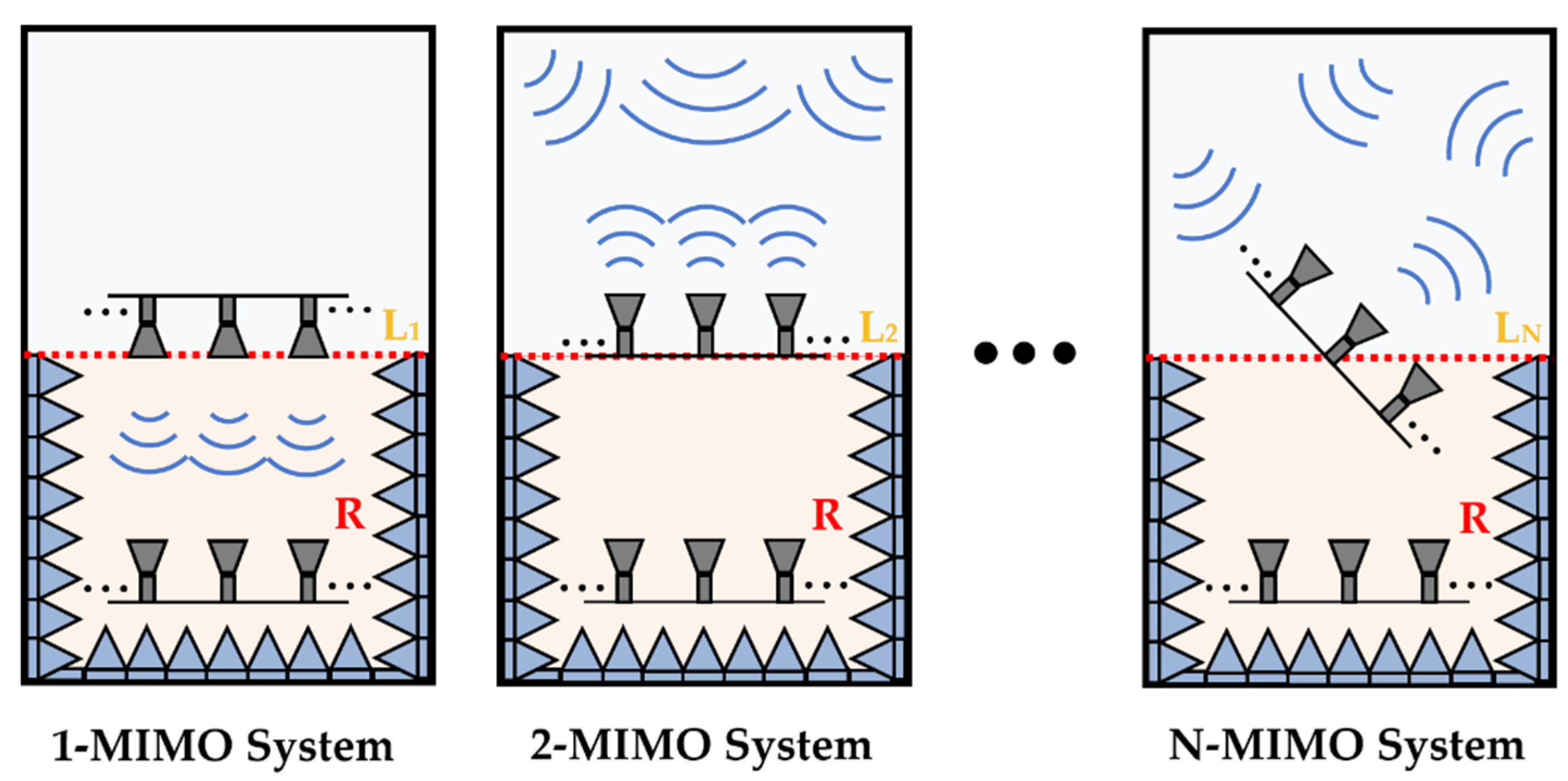
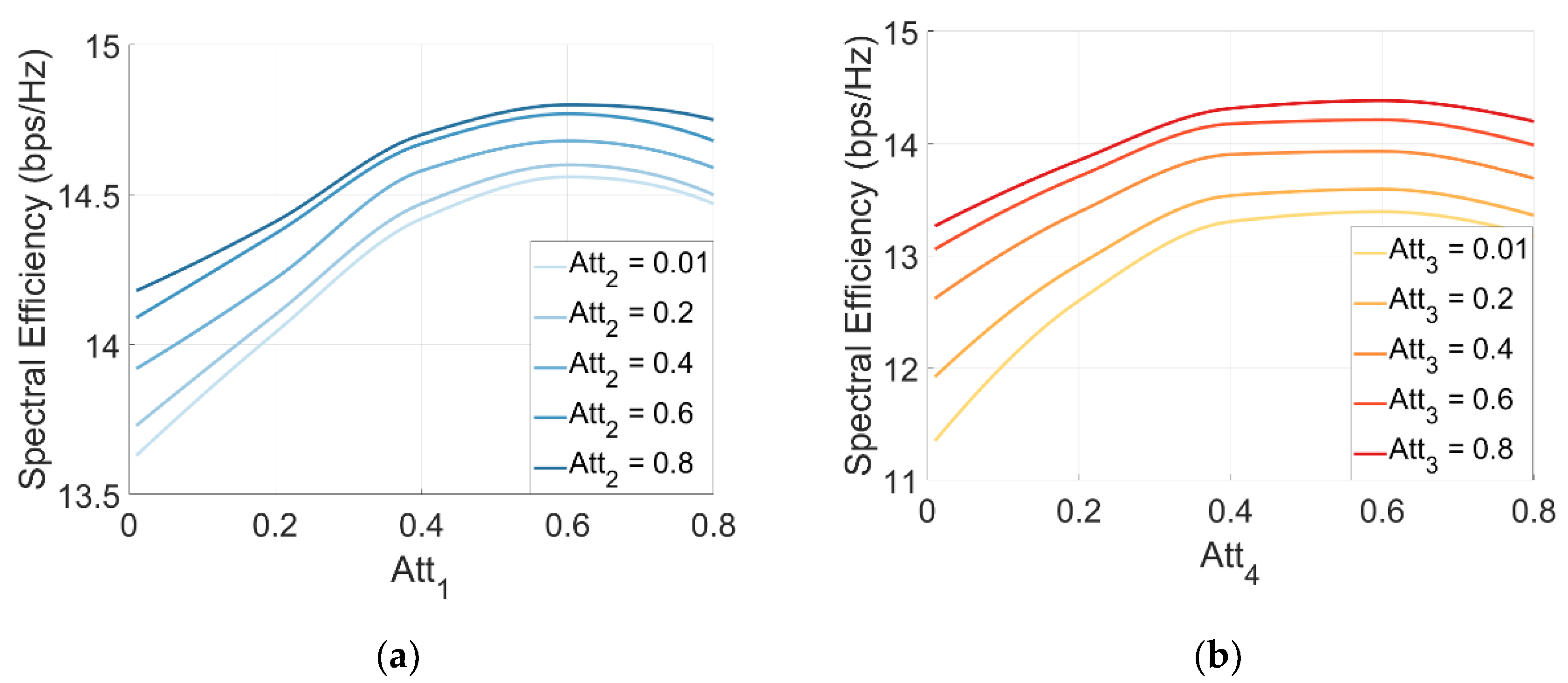
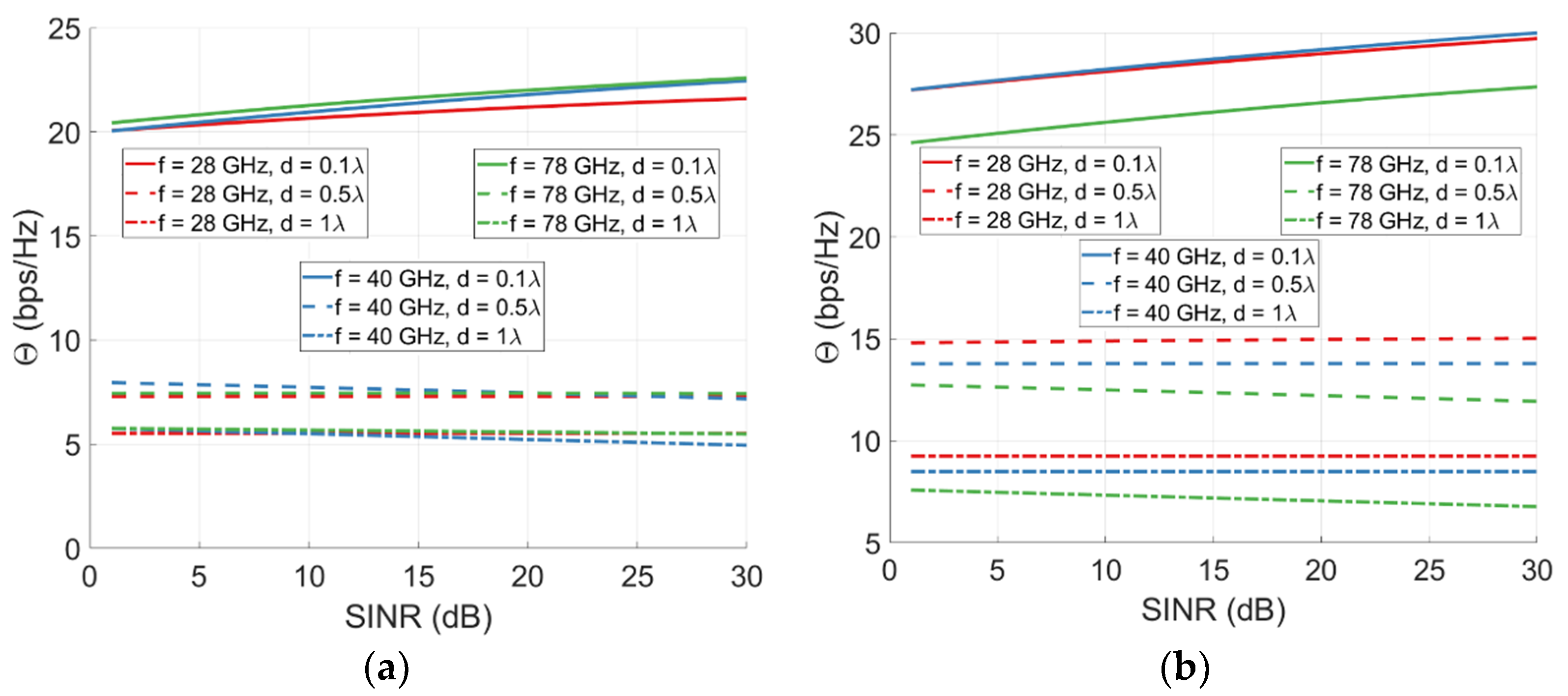
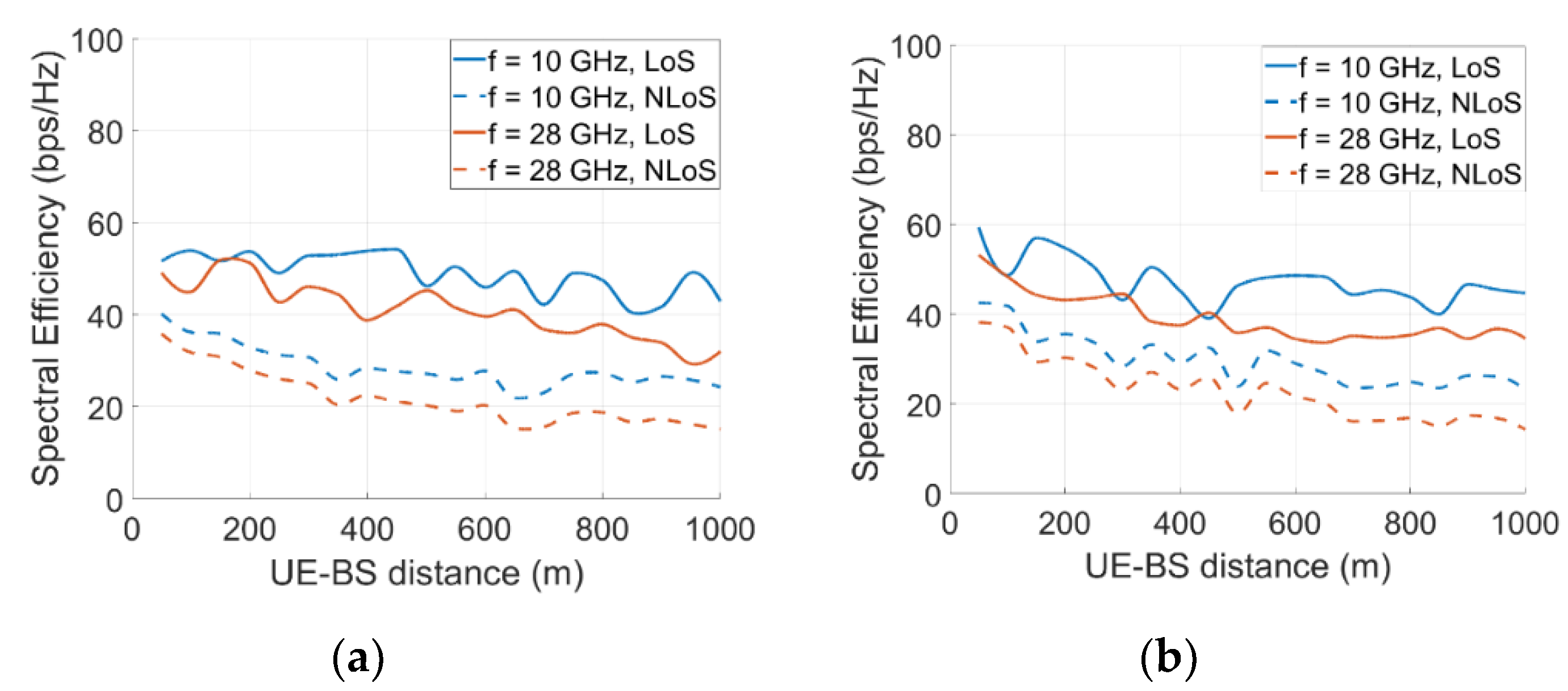
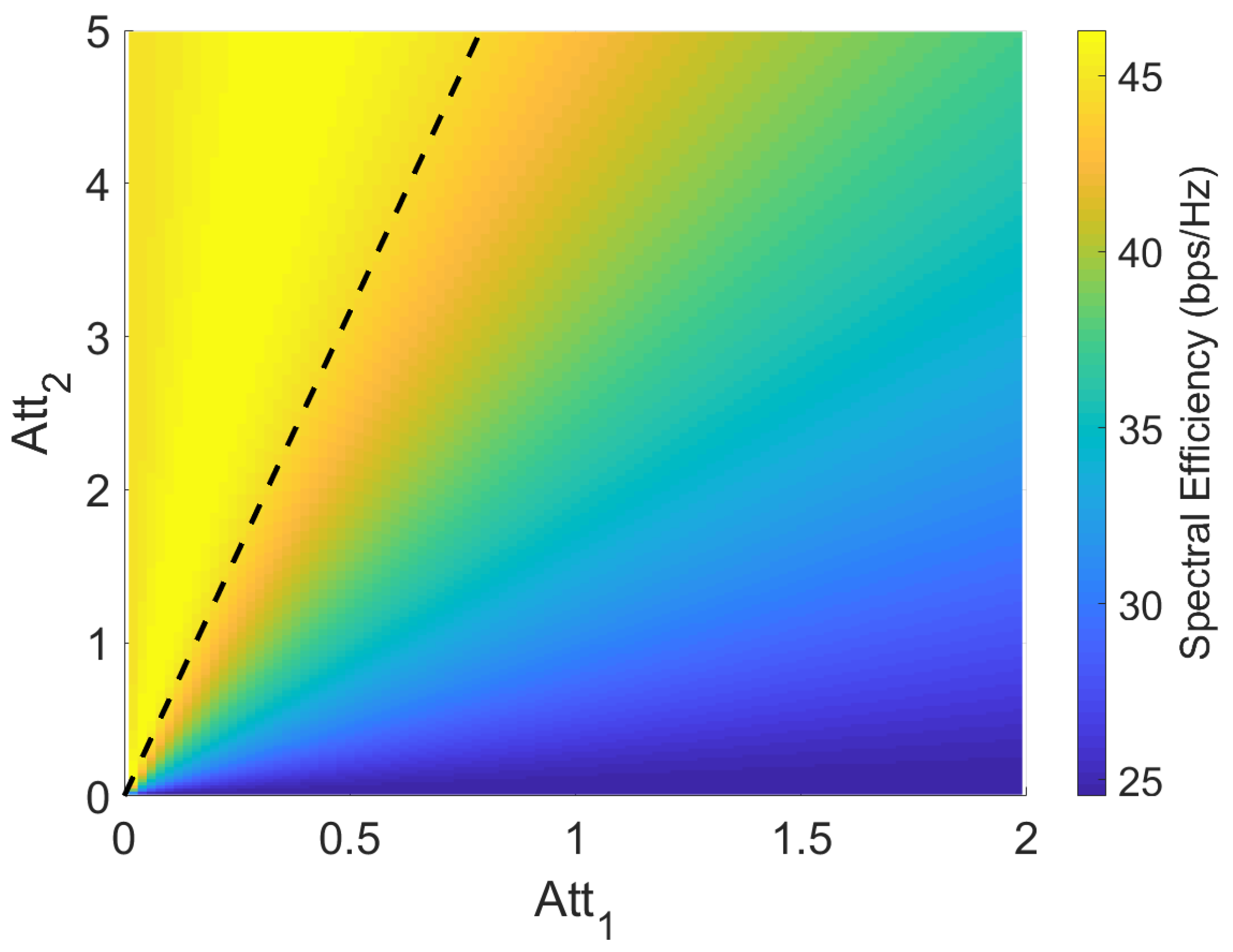
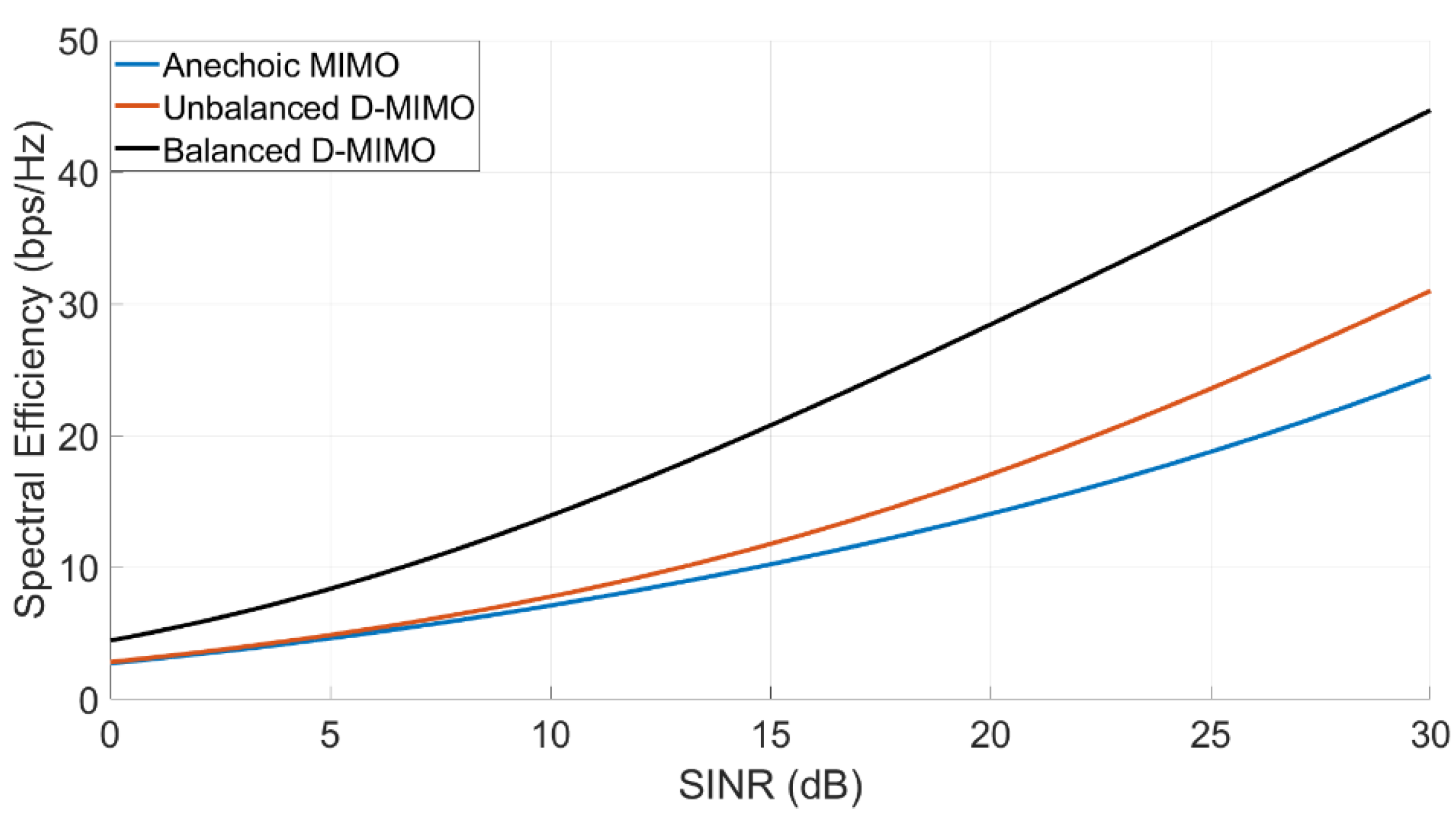
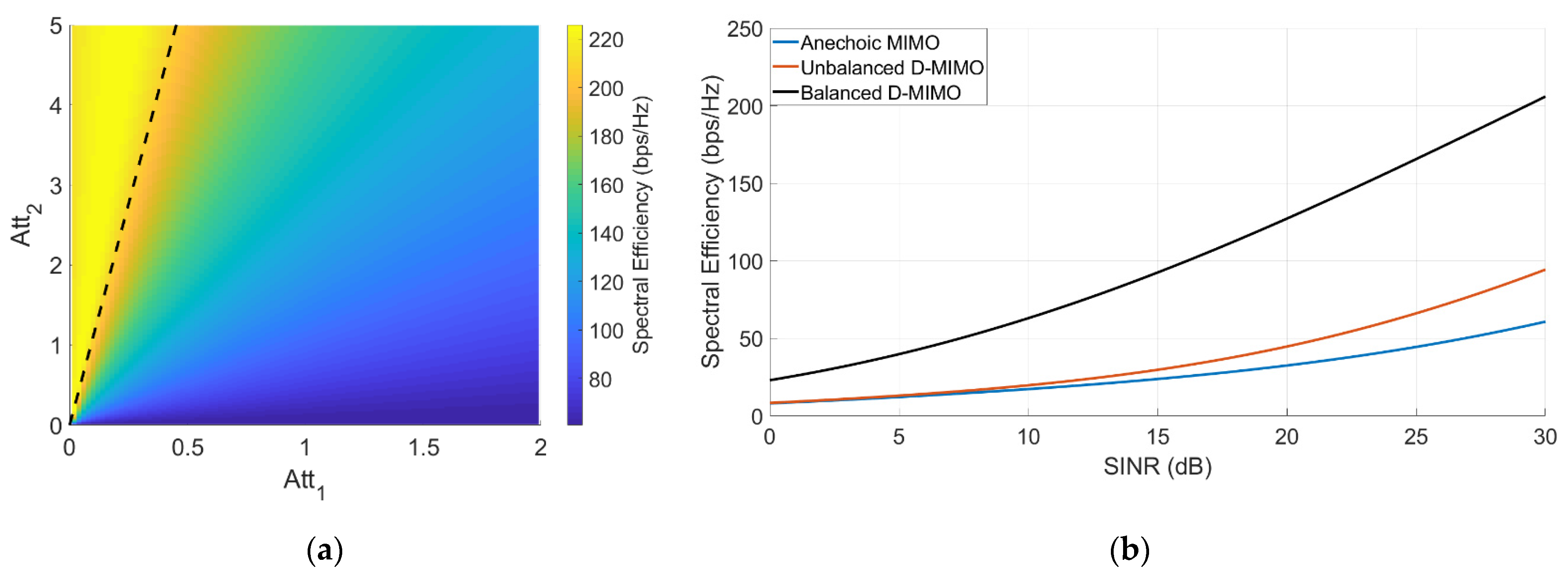
| A (H1) | B (H2) | C (H3) | D (H4) | E (H5) | F (H6) | G (H7) | |
|---|---|---|---|---|---|---|---|
| Power allocation | 1 | 0.48 | 0.36 | 0.85 | 0.58 | 0.15 | 0.14 |
| Simulation Parameters | |
|---|---|
| Frequency | 10 GHz, 28 GHz, 40 GHz and 78 GHz |
| Bandwidth | 800 MHz |
| Frequency samples | 1601 (500 kHz frequency spacing) |
| Propagation environment | Urban macrocell (UMa) and urban microcell (UMi) |
| Visibility | Line-of-sight (LoS) and non-line-of-sight (NLoS) |
| UE-BS distance | 50 to 1000 m |
| TX antennas in the BS | 200 antennas (Lineal array) |
| RX antennas in the UE | 20 antennas (Lineal array) |
| TX antenna separation | λ/10, λ/2 and λ |
| RX antenna separation | λ/10, λ/2 and λ |
| EIRP | 30 dBm |
| Iterations | 10 |
Publisher’s Note: MDPI stays neutral with regard to jurisdictional claims in published maps and institutional affiliations. |
© 2021 by the authors. Licensee MDPI, Basel, Switzerland. This article is an open access article distributed under the terms and conditions of the Creative Commons Attribution (CC BY) license (https://creativecommons.org/licenses/by/4.0/).
Share and Cite
Ramírez-Arroyo, A.; González-Macías, J.C.; Rico-Palomo, J.J.; Carmona-Murillo, J.; Martínez-González, A. On the Spectral Efficiency for Distributed Massive MIMO Systems. Appl. Sci. 2021, 11, 10926. https://doi.org/10.3390/app112210926
Ramírez-Arroyo A, González-Macías JC, Rico-Palomo JJ, Carmona-Murillo J, Martínez-González A. On the Spectral Efficiency for Distributed Massive MIMO Systems. Applied Sciences. 2021; 11(22):10926. https://doi.org/10.3390/app112210926
Chicago/Turabian StyleRamírez-Arroyo, Alejandro, Juan Carlos González-Macías, Jose J. Rico-Palomo, Javier Carmona-Murillo, and Antonio Martínez-González. 2021. "On the Spectral Efficiency for Distributed Massive MIMO Systems" Applied Sciences 11, no. 22: 10926. https://doi.org/10.3390/app112210926
APA StyleRamírez-Arroyo, A., González-Macías, J. C., Rico-Palomo, J. J., Carmona-Murillo, J., & Martínez-González, A. (2021). On the Spectral Efficiency for Distributed Massive MIMO Systems. Applied Sciences, 11(22), 10926. https://doi.org/10.3390/app112210926









